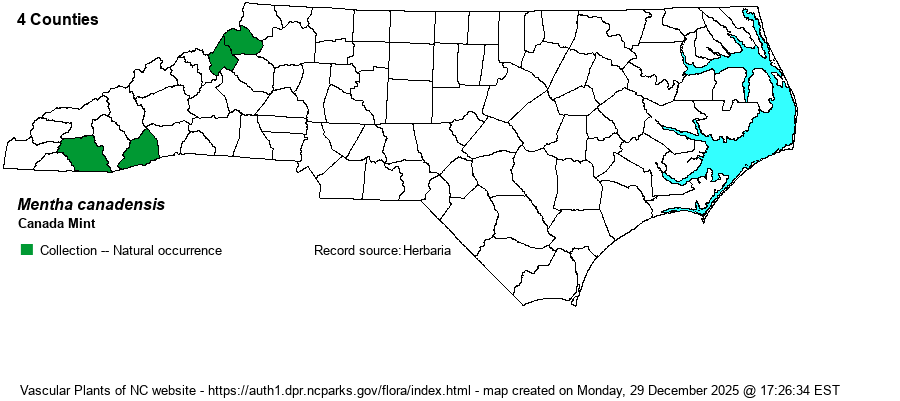| Author | L. | |
| Distribution | The taxonomic split between M. arvensis in the strict sense and M. canadensis -- a native species in N.A. -- has not carried over to many herbaria. Hardly any specimens have been annotated. Therefore, the website editors cannot with certainty identify each and every specimen. Nonetheless, collections from Avery, Macon, Transylvania, and Watauga counties appear to be good canadensis. Specimens from Orange County are from cultivated plants.
Native of the U.S. and Canada; ranges in the East south to much of VA, the NC Mountains, TN, and AR. | |
| Abundance | Rare. The NCNHP should put the species on its Watch List (W7), as more needs to be known about it. It is possible that botanists in the Mountains have seen it and failed to collect it, thinking it might well be not native to the U.S. | |
| Habitat | Seepage near cemetery, montane bog, wet meadow; likely an obligate wetland species. | |
| Phenology | Flowering and fruiting June-August. | |
| Identification | Canada Mint features a series of 4-10 hemispherical clusters of densely-packed, pink to lavender flowers in axils of the leaves. Its leaves are tapered to the base, versus relatively rounded at the base in the non-native Field Mint (M. arvensis). | |
| Taxonomic Comments | Most references, especially older ones, simply included this taxon within M. arvensis, and thus as a species containing both North American and Eurasian populations, or with the assumption that all are simply Eurasian in origin.
| |
| Other Common Name(s) | American Wild Mint | |
| State Rank | [S2?] | |
| Global Rank | G5 | |
| State Status | [W7] | |
| US Status | | |
| USACE-agcp | | |
| USACE-emp | | |

